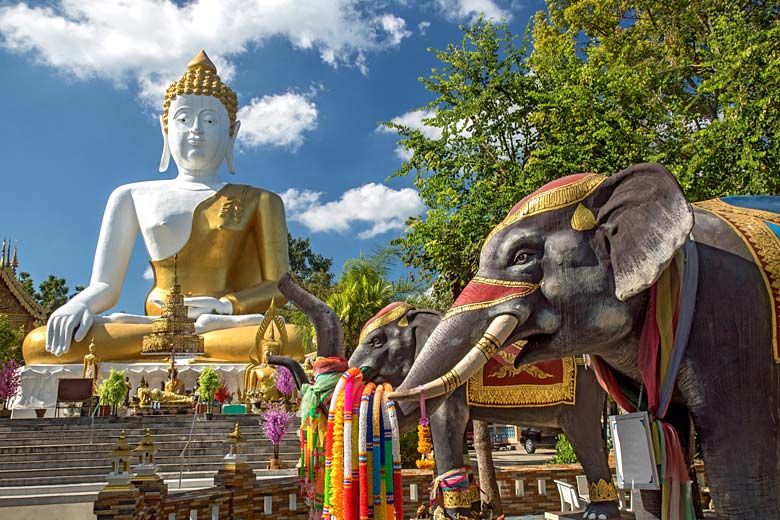- Book online with TUI & save up to 7% on holidays
- FREE child places available for select holidays
- Pay £0 deposits with direct debit & spread the cost
Thailand weather by month
Check out Thailand weather averages by month. Compare detailed monthly climate statistics including temperature, rainfall and sunshine figures.
| Jan | Feb | Mar | Apr | May | Jun | Jul | Aug | Sep | Oct | Nov | Dec | |
|---|---|---|---|---|---|---|---|---|---|---|---|---|
| Maximum daytime temperature °C |  32 32 |
 33 33 |
 34 34 |
 35 35 |
 34 34 |
 33 33 |
 33 33 |
 32 32 |
 32 32 |
 32 32 |
 32 32 |
 31 31 |
| Hours of sunshine (daily) | ||||||||||||
| Days with some rainfall |  1 1 |
 3 3 |
 3 3 |
 6 6 |
 15 15 |
 15 15 |
 17 17 |
 19 19 |
 20 20 |
 16 16 |
 6 6 |
 1 1 |
More about Thailand
Thailand by month
Jan Feb Mar Apr May Jun Jul Aug Sep Oct Nov Dec
Recommended for Thailand
The climate guide for Thailand (Bangkok) shows long term monthly weather averages processed from data supplied by CRU (University of East Anglia), the Met Office & the Netherlands Meteorological Institute. Find out more about our data sources.
Top Thailand destinations
Below are average maximum temperatures at popular countries, regions and places in Thailand for next month - January. Select a destination to see the climate guide for all months of the year.
All Thailand destinations
- Bangkok
- Cha Am
- Chiang Mai
- Chiang Rai
- Hat Yai
- Hua Hin
- Kanchanaburi
- Khao Lak
- Khao Sok National Park
- Khao Yai National Park
- Koh Chang
- Koh Samui
- Krabi
- Mae Hong Son
- Nakhon Ratchasima
- Nan
- Nong Khai
- Pattaya
- Phi Phi
- Phuket
- Sukhothai
- Surat Thani
- Ubon Ratchathani
- Udon Thani
Metric (°C / mm) | Imperial (°F / inches)
Thailand climate overview
Thailand is a country with a rich history and distinct cultural identity centred on the Buddhist religion and a respect for tradition. These things, combined with a warm climate and spectacular landscapes, from forested mountains to golden sandy beaches, make it one of the most popular tourist destinations in Asia today.
Geographically Thailand can be divided into four regions. In the north, centred on Chiang Mai, and along almost the entire length of the border with Burma, are mountains.
To the east towards the border with Laos is the Korat Plateau, a relatively arid region characterised by undulating hills. Between these is the central lowland plain, an incredibly fertile area, where most of the population lives and where the capital Bangkok is located.
In the far south is the southern peninsular that stretches all the way down to the border with Malaysia. This is where most of the beach resorts can be found, such as Phuket and Krabi.
The weather in Thailand is dominated by the two Asian monsoons. From May to October the south-west monsoon brings moisture from the Indian Ocean that falls as rain, peaking in August and September in the north, and a month or two later further south.
From October to February the wind direction is reversed and a cooler drier north-east monsoon wind blows off the Asian landmass, bringing a dry season. Temperatures fall slightly in the dry season but this is only really noticeable at night.
There is a short transitional period between the monsoons during March and April. This is the hottest time of the year over the whole country. In the far south proximity to the sea moderates the heat somewhat, however some parts of central Thailand can become almost unbearably hot and humid in April and May.
With the onset of the monsoon in May temperatures drop slightly and cloudier conditions persist through to October in the north, and right into December in the south particularly on Gulf of Thailand coast to the south of Koh Samui. However this east coast also gets less rain than the west coast in the early part of the wet season from May to October.
Thailand is largely protected from the full force of typhoons that affect the South China Sea by the landmass of Laos, Vietnam and Cambodia lying between it and the ocean to the east.
Usually dissipated storms affect only the north of the country, particularly in September and October when they can bring a lot of rain and flooding. However very occasionally one will slip into the Gulf of Thailand to the south of Vietnam and strike the far south of the country.
In December 2004 all coastal areas on the west side of the peninsular were severely affected by the Boxing Day Indian Ocean Tsunami, which also led to great loss of life.
More about Thailand
Compare Thailand with the UK
Below the Thailand chart shows average maximum daytime temperature for Thailand (Bangkok) and the UK (London).
Maximum daytime temperature (°C)
Metric (°C / mm) | Imperial (°F / inches)
Compare more Thailand weather >>
Be inspired
Get your weekly fix of holiday inspiration from some of the world's best travel writers plus save on your next trip with the latest exclusive offers
We promise not to share your details
Related posts
Popular travel offers
Explore holiday destinations
- Beach holidays
- City breaks
- Family holidays
- Half term holidays
- Spring holidays
- Summer holidays
- Autumn holidays
- Winter sun holidays
- Honeymoons
- Coolcations
- Compare places
- Ski resorts
Save with latest deals & discounts
- Holiday offers
- Top travel brands
- Airlines & flights
- Discount hotels
- TUI
- Jet2holidays
- Neilson
- Marella Cruises
- Pierre & Vacances
- Caledonian Travel
- Club Med
- Boxing Day sales
Airport parking
- Manchester Airport
- Stansted Airport
- Bristol Airport
- Luton Airport
- Birmingham Airport
- Edinburgh Airport
- Gatwick Airport
- Glasgow Airport
- Newcastle Airport
Airport lounges
- Manchester Airport
- Birmingham Airport
- Bristol Airport
- Edinburgh Airport
- Glasgow Airport
- Heathrow Airport
- Newcastle Airport
- Stansted Airport
- Gatwick Airport















 TUI deal finder
TUI deal finder






